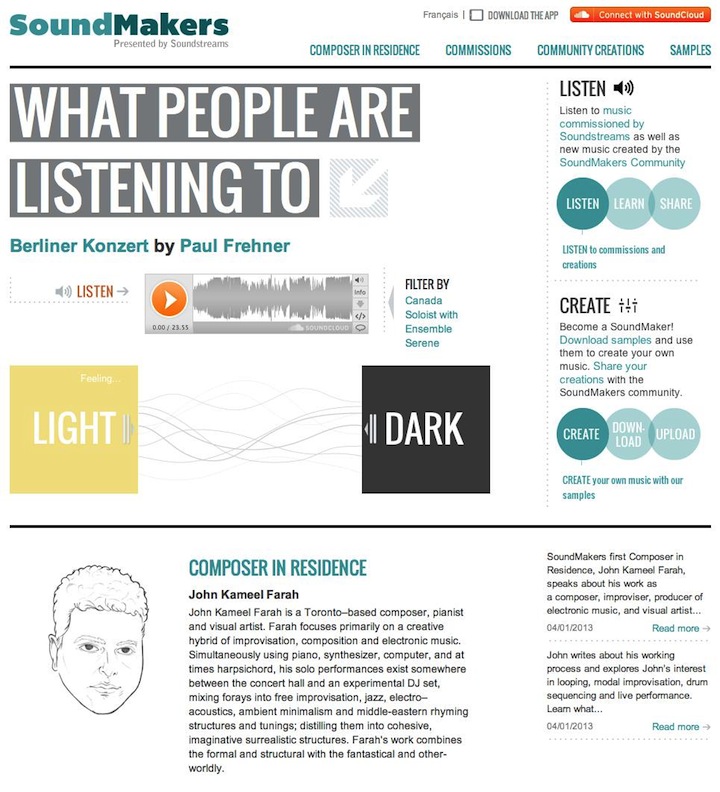Soundstreams yesterday unveiled SoundMakers a website that extends the idea of a digital archive by making a substantial amount of the recorded content available for manipulation. It’s a beautiful showcase of creative possibilities placed at the fingertips of anyone who wants to actively engage with new music in the safety of their private environment.
- Classical Music 101: What Does A Conductor Do? - June 17, 2019
- Classical Music 101 | What Does Period Instrument Mean? - May 6, 2019
- CLASSICAL MUSIC 101 | What Does It Mean To Be In Tune? - April 23, 2019
Having an online archive is one thing, but figuring out how to make it into a living entity rather than a catalogue bedecked in virtual cobwebs is another.
Soundstreams started by compiling all the recordings CBC Radio had made of its concerts over the years, getting permissions and transferring the music, piece by piece into SoundMakers. (This is also a very painful reminder of how the CBC has shrunk in its radio activities recently — but that’s another topic.)
So, first of all, we get a catalogued, curated record of new Canadian and international compositions representing many years of concert presenting and commissioning by Soundstreams. And it’s not just obscure stuff; one finds pieces by R. Murray Schafer alongside those of Steve Reich on the site.
Allowing people to interact with the music is one way to bring the stored material to life, so SoundMakers goes beyond allowing listeners to stream each track. Whether on a regular computer or on a mobile device via an app, visitors to SoundMakers can download music samples and mix them into their own special something.
The software is set up to work within the currently popular aesthetic of building layers of note patterns, which allows people from just about any background to create something that suits their taste.
But it doesn’t end there.
There is a professional composer involved in all of this, as well.
Pianist-composer John Kameel Farah is the official composer-in-residence at SoundMakers, acting as a guide.
Over the course of the coming months, he will be creating a substantial new work that will, in part, use the samples available online. He is supposed to chronicle the experience in detail on the site’s blog and answer questions from visitors.
The audio archive is set up on SoundCloud, making it easy to click-and-play, as well as fast-forward through a piece.
It’s a massive job to get something like this set up, including providing many of the pieces with visual samples of the score as well as an opportunity to buy the score.
Soundstreams says the archive represents three decades of work, but the oldest piece I could find was recorded in 1987 — a cantata by Toronto composer Derek Holman. Still, that represents a full generation of Toronto new-musicmaking under one digital umbrella.
The presenter has done a lot of work with choirs over its history, so that means there are a lot of interesting choral creations in the SoundMakers archive.
What makes me especially happy is that a place like this allows people who would be too timid to check out a new music concert live to point-and-click their way through all sorts of sounds and hopefully discover that there is more to love and less to be intimidated by. To make that sort of browsing easier, a visitor can sift through the archive using a set of preferences, including mood — It’s all laid out here.
People can post their own creations on the site. As of this morning, only one piece had been created in SoundMakers, using samples from Vorwissen, a piece by Canadian composer Paul Steenhuisen. I gave it its first official play:
+++
It was great to reconnect with the late Harry Freedman. It’s been less than eight years since he died, but we rarely hear his music anymore.
Soundstreams premiered a piece of his called Valleys in 2002, where the audience was the valley and the choristers represented the surrounding hilltops. And rather than worry about making surround-sound words intelligible, Freedman wrote a text in gibberish, so that the experience would be a purely sensual state of being surrounded in sound rather than a quest for meaning.
You can’t duplicate the experience with the speakers on an iPad, but you can at least get the idea — and that’s where it all starts:
John Terauds
- Classical Music 101: What Does A Conductor Do? - June 17, 2019
- Classical Music 101 | What Does Period Instrument Mean? - May 6, 2019
- CLASSICAL MUSIC 101 | What Does It Mean To Be In Tune? - April 23, 2019




